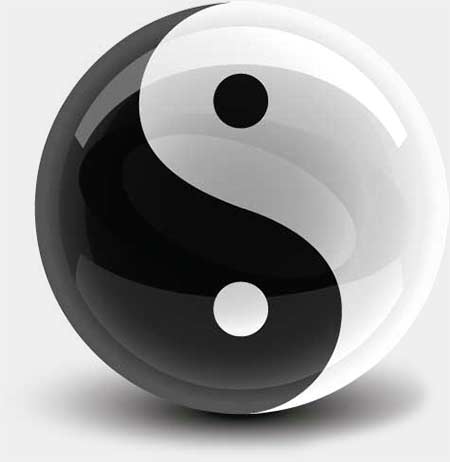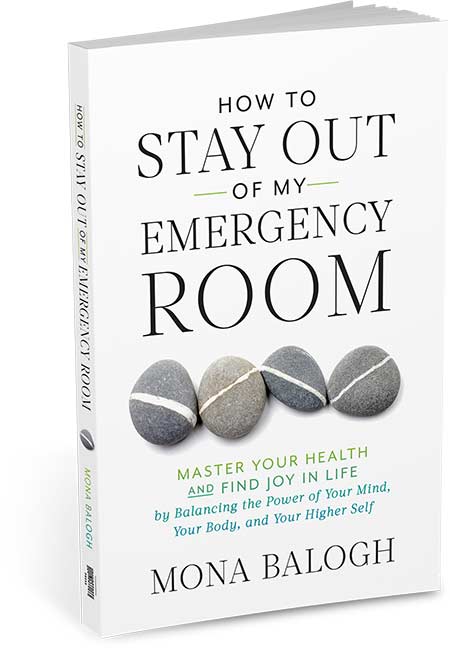Over the course of twenty-seven years treating patients in emergency rooms, Dr. Mona Balogh observed a tendency — from diabetes to addiction — for some people to chronically use ERs to address their disease when lifestyle changes could help their condition immensely.
How to Stay Out of My Emergency Room addresses a panoply of bad habits and addictions through captivating stories of Dr. Balogh’s interactions with patients who repeatedly returned to her emergency room due to their tendency to avoid making lifestyle changes.
The second part of the book moves into action, presenting a roadmap to creating healthy new habits complete with worksheets. By applying the Eastern concept of balance of opposing forces with the 12 Steps and Vipassana-inspired meditations, the book provides a foundation for the reader to help themselves escape from whatever unhealthy rut in which they find themselves. And In a series of powerful meditations we get in touch with our Higher Self.
How to Stay Out of My Emergency Room calls upon time-honored principles to help us stop blaming everybody and everything around us and use tools outlined in the book to fulfill the vision that we have for ourselves and our life.
Not since the 7 Habits of Effective People has there been an “instruction manual” that powerfully presents such a positive program of living. This book will be useful to the health professional, the caregiver and for anyone who is ready to do what is necessary to transform their lives and become their very best self.
EXCERPT
On the simplest level of existence, if you don’t constantly take in good stuff and get rid of bad stuff, you die. If you fail to inhale and exhale, you will die in minutes. If you fail to eat and excrete, you will die in days.
If you’re constantly taking in more smoke and pollutants than your body is getting rid of—it might take years, but eventually, the imbalance will kill you.
It’s the same for calories.
It’s the same for alcohol. Tobacco. Narcotics. Weed.
It’s the same for bad ideas. Abusive spouses. Nasty bosses. Dangerous friends.
As you face these challenges, you may realize that your Self may be unique, but your situation may not be. Some kind of bad stuff is coming at everyone all the time, right along with the good stuff. No matter what you may think, the universe is not after you specifically, it’s after everyone.
Everyone has to work to take in more good than bad—then efficiently get rid of the bad. Every day.
It’s our job.
Seeing the Good and Bad
The difference between good stuff and bad stuff can be hard to see in some parts of your life.
Good ideas and bad ideas are especially tough to separate. But if we don’t take in the good ideas and get rid of the bad ideas, eventually the bad ideas will come to dominate us, just by the downward pull of entropy.
Since entropy is represented by yin, we'll just call all the bad stuff yin. The bulk of this chapter describes negative yin stuff. As a mental exercise, try to imagine what persons, objects, beliefs, and behaviors in your life are yin.
Here's a sample list:
Yin Persons
Yin persons cause bad feelings and bad behaviors. For example, my former neighbor's son, who played his music very loudly, especially late at night; my neighbor herself, to whom I complained multiple times but she either didn't care or was afraid of her son; the landlord of the people across the street from me, who refuses to repair their septic tank that regularly overflows and stinks up the neighborhood. It’s especially bad when yin persons become our close companions. Indeed, every day we encounter good companions and bad companions—people who can lead us down a happy or an unhappy path. If we don’t choose the good companions and shun the bad companions, one of those bad companions will screw up our lives.
Yin Objects
Any object that is degenerating or useless or harmful can be considered a yin object. For example, a car parked in my neighborhood that has been there for several years, has four flat tires, is collecting dirt and is obviously abandoned; several dead trees in my neighborhood; rodents, specifically gophers, that dig up my yard and have no known redeemable features, at least not in my eyes.
Yin Beliefs
Any belief that causes the destruction of goodness can be considered a yin belief. This includes hatred of good (true love, kindness, wisdom, helpful people, competence, excellence, accomplishment), and love of bad (envy, cynicism, rage, murder, sloth, theft, greed).
Yin Behaviors
Yin behaviors are intentionally mean-spirited and lead to damage, decay/disease, or death. Such behaviors include acts of malice, spite, viciousness, bitterness, ill will, cynicism, arrogance, rage, sarcasm, scorn, taunting, and bullying, to name a few.
The Principle of Separation
Once you identify the bad stuff in and around you, you must first figure out how to separate from it. Then you must figure out how to step away from it. Not always simple, but absolutely necessary. You will not be able to make the bad stuff disappear from the earth, but you can always separate and step away from it.
Remember that Tricky Dot

As we try to separate good from bad, it’s crucial to remember that the yin always has that little dot of yang in it—a dot that can trick us. A bad companion may make us feel temporarily good. A bad idea will get us momentarily excited. Alcohol will relax us. Inappropriate sex will thrill us. A narcotic will ease the pain.
ADAPTED SAMPLE
Regaining Power Over Your Health
Renee Kemper
The following article by Renee Kemper that appeared on BookBites July 9, 2020 is adapted from How to Stay Out of My Emergency Room by Mona Balogh.
In my ER, we call them our frequent flyers. They touch down again and again from ambulances in the middle of the night. They’re wheeled in again and again by desperate, frustrated family members. We may even get to know them by name. We may hardly need to look at their charts.
They have congestive heart failure, but they ate a whole bag of chips. They have diabetes but failed to take their insulin. They overdosed on Vicodin. They drank themselves into unconsciousness. They didn’t change the bandages on their bedsores for a week. They laid in bed for a week and lost all their muscle strength, so they fell. They cut themselves.
Again.
This advice is mostly for frequent flyers. It’s mostly for people who have so lost their personal power to a disease, a habit, or a destructive behavior that they end up in my ER every six months. Or every month. Or every week.
Mostly that means people with chronic conditions like diabetes, dangerous allergies, heart conditions, obesity, or autoimmune diseases. Conditions that could be controlled with things like diet and exercise, but are not.
It also means people who have knowingly or unknowingly become addicts: opioid addicts, sex addicts, food addicts, alcoholics, heavy smokers, you name it. Among addicts, I include people trapped in habitual violence: gun violence, gang violence, domestic violence.
Maybe you see yourself on one of those lists.
If so, I am here to give you strength. I’m here to give you a truly new kind of personal power. I‘m here to offer you an entirely new way to see the world and your place in it. I offer a new path forward, both mentally and physically. A path that works for anyone.
Even you.
Maybe you’re not a frequent flyer, but you’re the caring husband, wife, friend, brother, sister, or parent who needs to understand what’s really happening and why and learn to cope. You might even be a professional: a doctor, nurse, or CNA looking for a new way to empower your patients, and protect yourself, too. If so, this book is also for you. You need to understand your frequent flyer.
I do not know a single person, including myself, who has not struggled to overcome a habit that damages their health. Who has not at some point felt weak in the presence of a bad habit. Who has not at some moment fought to maintain the balance of personal power that leads to health?
Not one.
Think, for a moment, what that means.
Destructive habits are strangely woven deep into the human condition — curiously fundamental to the daily wrestling match that constitutes life itself.
Whether we are aware of these habits, or whether they operate stealthily beneath our conscious minds, we must all learn to see and confront them every single hour of our lives, right up until the hour we die.
Not Another Load of Advice.
I’m not one more doctor hectoring you to take your meds and follow your diet.
Instead, I ask that you look at the dark and the light halves of human existence. I ask that you examine the eternally opposing forces that lead us all to harm or to help ourselves, day in and day out. It explores the unacknowledged “power plays” which make every one of us prey to destructive habits.
Only by understanding these forces can we control and balance them. The forces themselves will never be eliminated.
I do not pretend to originality. These ideas here are not just old, but ancient. You might say they’ve been clinically proven by billions of trials over thousands of years. People much smarter than me have been thinking about this problem throughout the millennia. Those people found solutions — we just need to use those solutions in a modern context.
Once acknowledged and understood, we can use our Higher Self to retrain our brains with some very practical mental exercises.
These mental exercises will inevitably improve your health. I promise.
One warning: as you explore these subjects, you will encounter some hard truths.
Some very hard truths.
But without confronting those truths, no progress can be made.
The Bottom Line.
Before we get to those truths, however, let me cut to the bottom line.
I’m an MD with twenty-seven years of experience in the emergency rooms of large hospitals, thirty-four years if you include medical school and residency. I’ve seen literally tens of thousands of patients. I’ve studied both Western and Eastern approaches. Here is what I have learned:
Health is life. Life is a precarious balancing act. But that balance is possible to achieve by anyone who still has their cognitive abilities.
Anyone.
No matter how sick you may be. How immobile. How addicted to pizza, donuts, cigarettes, tequila, Demerol, pistols, razor blades, soft couches in front of TVs, or the bright lights of the ER at midnight.
You too can regain power over your health.
You too can become independent. You too can say goodbye to ambulance drivers and hospital orderlies.
With any luck, you may never have to look up into my masked face or feel the touch of my gloved hands again.
To learn more about regaining power over your health, you can find How to Stay Out of My Emergency Room on Amazon.
